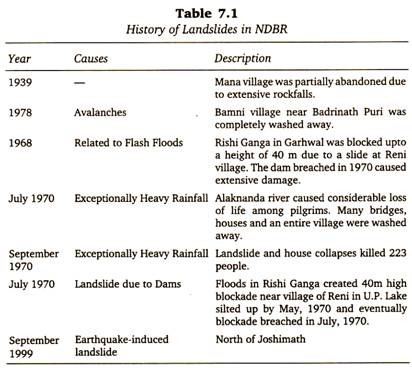Man Induced Landslides
Human Factors in Man Induced Landslides:
These are basically the human activities like construction of roads, buildings, dams, etc. These have strong bearing on the Man Induced Landslides. First road in Himalayan region was introduced way back in the British colonial period (Singh and Ghai, 1996). It was, however, only after the Indo-China war of 1962 that the road construction was intensified in the Himalayas.
Thereafter, Indian engineers blasted gigantic networks of road and communication facilities deep into hills of the Himalaya. In NDBR, the history of road construction began in the sixties. In 1964, for the first time, roads were constructed in the reserve. Local people reported that initially about 80 km of roads were constructed in the region. About 50 km of road were further added to the existing network of roads in 2000.
Presently, road length is about 135 km Now the road in Mana valley has been declared as national highway (Haridwar-Badrinath National Highway) due to which slopes are now in the process of being over-modified. Thus, sheer stress factors are exceeding sheer strength factors and landslides are increasing. After the introduction of roads, landslides have become very frequent in the reserve. The correlation between construction of roads and landslides is positive (Figure 7.2). It has the three stage relations.
First stage, which is the pre-modified stage of natural slope, the steady-state condition is found (Figure 7.2a). Then, the natural slopes are modified or undercut for the construction of roads and dams, etc. Thus, steady-state condition is disabled (Figure 7.2b).
Man Induced Landslides
Then landslides take place so that steady-state condition is reestablished (Figure 7.2c). Therefore, landslides can be said nature’s rule of equilibrium.
Built-up land has also increased in the recent past due to which natural slopes have been over-modified. It has also led to deforestation in the reserve. Thus, steady-state condition has disabled in many areas, which have eventually resulted in increased frequency of landslides.
Strong positive correlation between occurrence of landslides and construction of roads were observed during the field investigations. Villagers reported that earlier landslides were not very common but after the introduction of roads, this has become a common phenomenon. About 80 per cent of the total landslides occurring now in the reserve are a result of road construction.
According to field survey, most of the villagers consider that road construction excessive rainfall and seismicity are main causes of landslides. About 83.5 per cent, 88 per cent, and 88.5 per cent of the respondents reported road construction, excessive rainfall and seismicity respectively as the most common causes of landslide occurrence in the reserve. Whereas declining forest cover, grazing and agricultural land expansions are other causes of landslides (Figure 7.3).
Man Induced Landslides
Agriculture, grazing and deforestation are commonly regarded as the main causes of landslides in other Himalayan regions but these were reported as minor causes of landslides in the reserve, which is the result of ban on utilization of local resources in the reserve. Road construction has been the prime cause of landslides in the region.
Most of the region is located in the peri-glacial and glacial environment. So, ideally, there should be much snowfall rather than rainfall. But local people reported that snowfall has decreased and rainfall has increased in last few decades. This can be attributed to global warming due to which rainfall regions are shifting upwards and taking place of snowfall in the reserve. Thus, excessive rainfall in the first half of monsoon saturates the bedrock and in latter half removes it in the form of landslides.
Road construction and rainfall have increased in the reserve thus landslides have also become very frequent. Survey results show that the landslides have been increasing rapidly in region since last three decades, as about 51 per cent of the respondents reported the same, while 33 per cent reported that landslides are increasing slowly and only 16 per cent stated that trend of landslide is almost static (Figure 7.4).
Man Induced Landslides
Historical trend of major landslides in reserve has been constructed on the basis of literature and field survey. A total of 10 major landslides have been noticed in literature. There must be some more massive landslides in the region.
However, these are not properly documented due to the fact that most of the reserve is highly inaccessible to the outer world. Thus, most of the landslides of the reserve remain unregistered. A very interesting fact can be seen that almost all the landslides which are documented are natural (Table 7.1).
Man Induced Landslides
During field survey, about 40 landslides were noticed in the reserve (Figure 7.5). Of the total landslides, about 31 were human-induced and 9 were natural. All the human-induced landslides have recent origin. Thus, it can be said that human activities have aggravated the problem of landslides only in recent past.
Man Induced Landslides
Presently, intensity of landslide occurrence is high in NDBR as about 87 per cent of the respondents indicated the same, whereas only 13 per cent indicated moderate, low and very low intensity (Figure 7.6). People who reported moderate, low and very low intensity of landslides inhabit upper reaches of river valleys and practice seasonal migration.
During monsoon, upper reaches receive less rainfall, thus landslides are not as common as in lower reaches of the river valley. During winters, when avalanches take place, inhabitants of upper reaches migrate to low altitude and do not witness cases of frequent landslides.









